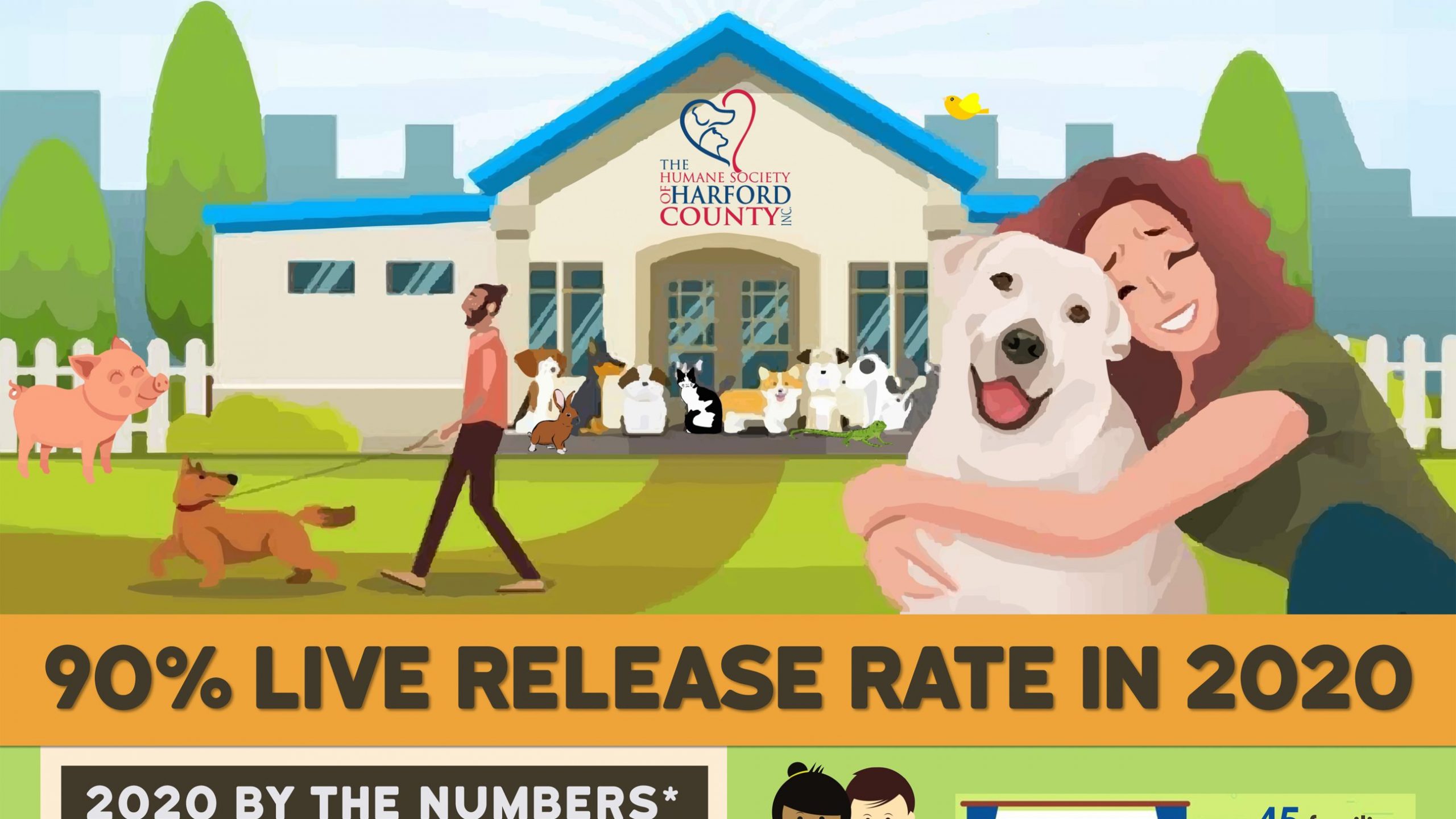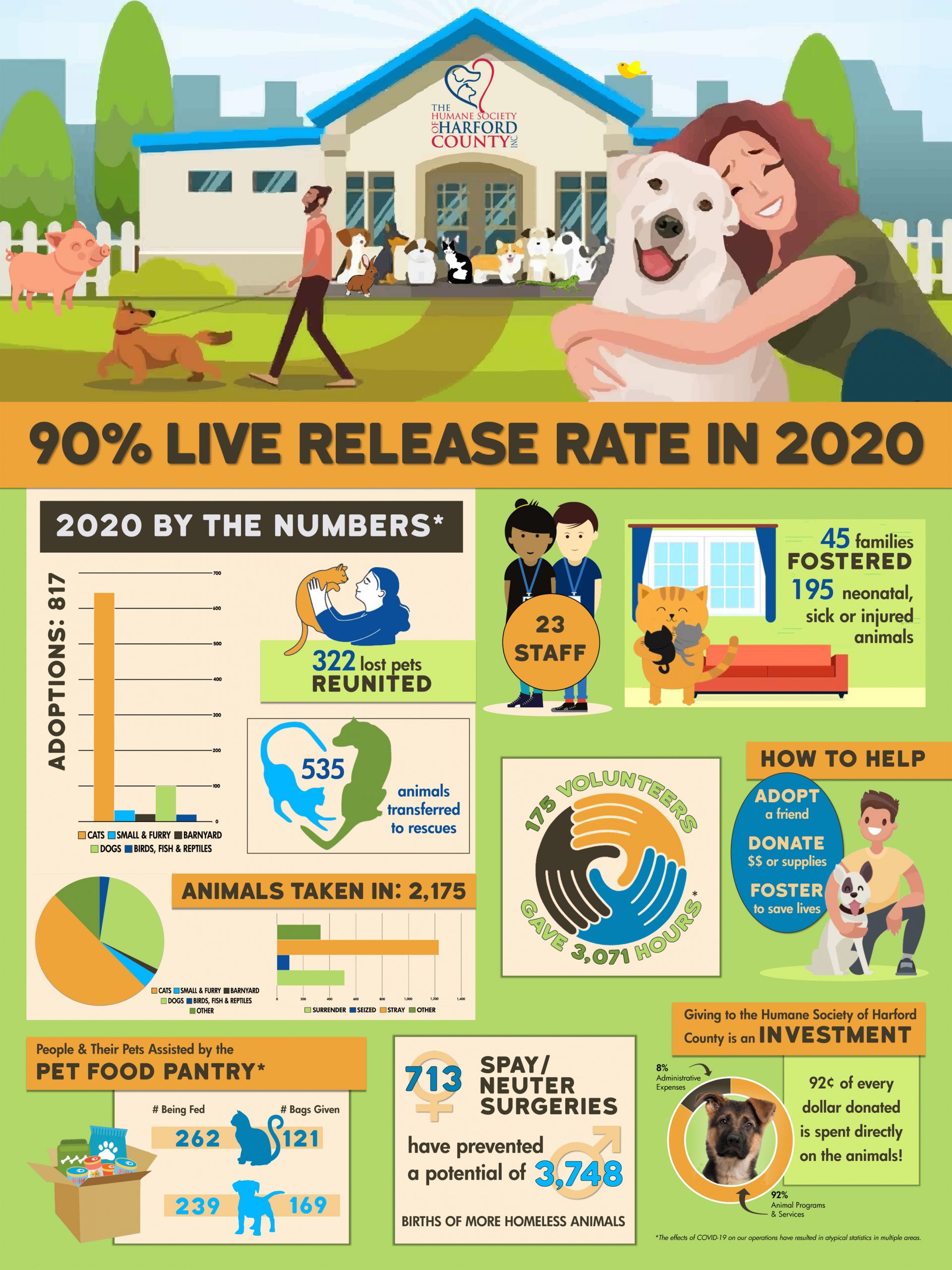
The Humane Society of Harford County (HSHC) has finished another extraordinary year with a 90% live release rate in 2020 for the fifth consecutive year. While 2020 was a year fraught with challenges, it was also a year of many highpoints, and definitely a year of resiliency for HSHC. When the pandemic hit early last year, the facility had to quickly pivot its operations: drastically limit public access inside the building, go virtual as much as possible to assist our clients, cancel in-person fundraising events, and suspend most volunteer activities. At the conclusion of the year, 90% of the 2,175 homeless animals that came through the shelter found placement. And for that, HSHC is extremely grateful.
A shelter’s live release rate is a mathematical equation that represents the percentage of animals that left the shelter alive, whether through adoption, reclaimed by an owner, or transferred to a rescue. It reflects how well the shelter is performing to ensure that the community’s neediest animals are receiving the loving care and second chances they deserve.
“There’s no denying that COVID-19 had a significant impact on our operations,” said executive director, Jen Swanson. “We saw some atypical statistics in multiple areas. For instance, our intake was down by about 20%, but this is a trend that’s happening in shelters nationwide due to the pandemic.”
In 2020, HSHC took in an average of 6 new animals each day, including cats and dogs; rabbits, guinea pigs and other small and furry animals; farm animals; and exotics such as birds, fish and reptiles. Fifty-seven percent of the total number of animals entering the shelter came in as strays. Twenty-four percent were relinquished by their owners, while the other 19% were abandoned at the shelter, born at the shelter, seized by the Animal Control Services Division of the Harford County Sheriff’s Office, or by other means. Cats were sheltered most often, representing 50.2% of the shelter’s total intake followed by dogs at 29.7% and all others at 20.1%.

Finding placement for the animals – adopting them into loving homes, reuniting them with their owners, or releasing them into the care of rescue groups – is the shelter’s ultimate goal. In 2020, 817 animals were adopted and 322 animals were reclaimed. Most of the reclaimed animals were microchipped at no charge for their owners so if they go missing in the future, a quick scan of the chip will help the animal find its way home.
Furthermore, HSHC partners with many partner shelters and rescue organizations to give animals another opportunity to find a loving home and open up kennel and cage space at the shelter for new daily arrivals. Working with other organizations increases the likelihood of a happy outcome for all the animals. In 2020, HSHC transferred 535 animals to these partners.
This year, a new statistic makes its debut: 333 animals were spayed and 380 were neutered at the shelter prior to adoption. The average dog can have a litter of four puppies twice per year while the average cat can have four kittens three times per year. At this rate, the shelter prevented the potential birth of 3,748 unwanted animals!
With a paid workforce of about two dozen employees, the enormous task of operating a shelter is aided with the help of volunteers. Last year, despite the pandemic severely limiting what volunteers could do, 175 volunteers gave a total of 3,071 hours of service. Nearly four dozen families fostered 195 neonatal, sick or injured animals, most of which were kittens.
Rounding out the list of 2020 highlights, HSHC’s administrative fees (management and fundraising) have reduced to just 8%. “This means that 92 cents of every dollar donated directly benefits our animals,” Swanson said. “While many donors prefer to see this number as low as possible, it is important to remember that these are legitimate expenses that need to be reimbursed for HSHC to be sustainable, effective, and have impact. We want to change the world, and these costs are necessary to build the infrastructure of our goals.”
This year, anyone wishing to help make a difference are encouraged to spay, neuter and microchip their pets; adopt from a shelter or rescue; become a foster parent; support a virtual fundraiser; and donate funds or supplies.
About the Humane Society of Harford County
The Humane Society of Harford County, Inc., is a non-profit, 501(c)(3) charitable organization dedicated to the welfare and well-being of the approximately 3,000 animals that come to us each year. We promote the kind treatment of homeless, stray and abandoned animals by providing shelter, care, adoptions, and community education. We are not a county agency nor are we affiliated with any national or regional organization. Your tax-deductible donations, bequests, and proceeds from events are crucial to our life-saving efforts on behalf of the animals of our community.



